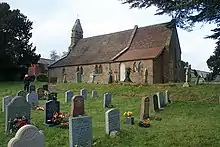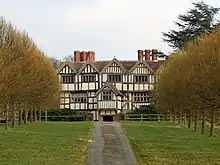Preston, Forest of Dean
Preston is a village, former manor and ecclesiastical parish in the Forest of Dean in Gloucestershire, England. It is situated 22 km north-west of the city of Gloucester and 4 km south-west of the Herefordshire town of Ledbury. In 1931 the parish had a population of 77.[1] In 1935 the parish of Preston, comprising 897 acres, was added to the parish of Dymock, adjacent at the south-east,[2] the parish church of which, St Mary the Virgin, is situated 4 miles to the south-east.

The parish church is dedicated to St John the Baptist.[3] To the immediate west of the church is Preston Court, a grade II* listed timber-framed manor house dating from about 1600,[4] in 2020 operating as "The Country House Collection" antique shop.
Descent of the manor

The manor of Preston had been a possession of Gloucester Abbey since before the Norman Conquest of 1066. In 1541, following the Dissolution of the Monasteries, it was granted as part of the endowment of the newly established See of Gloucester, the new Bishops of Gloucester using the old Abbey Church as their Cathedral. In 1583 the Bishop of Gloucester leased the manor to the Crown, and in 1585 Queen Elizabeth I granted it to Fulke Greville. After various changes in ownership, it was bequeathed by Henry Clements (d.1696)[5] of Epsom in Surrey to Anne Pauncefoot (d.1715), the widow of William Pauncefoot (d.1691) of Carswalls, Newent. It then passed to her granddaughter Sarah Pauncefoot (daughter of her son William Pauncefoot (d.1711)), wife of William Bromley (d.1769) of Worcester, later of Abberley in Worcestershire. Her son and heir was Robert Bromley (d.1803), who was succeeded by Sir George Pauncefote-Bromley, 2nd Baronet (1753–1808), "of of East Stoke, Nottinghamshire", also of Carswalls, Sheriff of Gloucestershire in 1775–6, who changed his name in 1778 to Bromley and in 1803 to Pauncefote.[6] Following the end of the life-interest of his mistress in 1834 Preston passed to the 2nd Baronet's cousin Robert Smith (d.1843) of Swansea, who adopted the surname Pauncefote and was succeeded by his son Robert Pauncefote (d.1847), who was succeeded by his brother Bernard Pauncefote, of India.[7]
See also
- Bromley baronets. The Smith, later Bromley, later Pauncefote-Bromley, later Bromley-Wilson, later Bromley Baronetcy, of East Stoke in the County of Nottingham, is a title in the Baronetage of Great Britain;
- Baron Pauncefote "of Preston in Gloucestershire"
References
- "Population statistics Preston AP/CP through time". A Vision of Britain. Retrieved 16 August 2020.
- 'Dymock', in A History of the County of Gloucester: Volume 12, ed. A.R.J. Jurica (Woodbridge, 2010), pp. 122-174.
- Listed building text
- Listed building text
- Possibly Henry Clements (1644–1696), MP for Carrickfergus, Ireland, in 1692 (The history and antiquities of the county of the town of Carrickfergus, etc ) and son of Edward Clements of Straid; in Carrickfergus Church there is a slab in memory of Henry Clements of Straid who died on the 2nd November, 1696, aged 52 years, being at the time Mayor of Carrickfergus
- 'Newent - Manors and Estates', in A History of the County of Gloucester: Volume 12, ed. A.R.J. Jurica (Woodbridge, 2010), pp. 38-54
- 'Preston', in A History of the County of Gloucester: Volume 12, ed. A.R.J. Jurica (Woodbridge, 2010), pp. 301-317